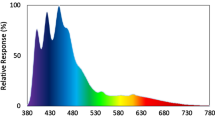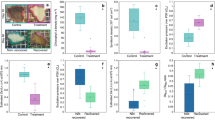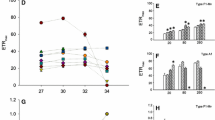Abstract
The branching zooxanthellate soft coral Sinularia flexibillis releases antimicrobial and toxic compounds with potential pharmaceutical importance. As photosynthesis by the symbiotic algae is vital to the host, the light-dependency of the coral, including its specific growth rate (μ day−1) and the physiological response to a range of light intensities (10–1,000 μmol quanta m−2 s−1) was studied for 12 weeks. Although a range of irradiances from 100 to 400 μmol quanta m−2 s−1 was favorable for S. flexibilis, based on chlorophyll content, a light intensity around 100 μmol quanta m−2 s−1 was found to be optimal. The contents of both zooxanthellae and chlorophyll a were highest at 100 μmol quanta m−2 s−1. The specific budding rate showed almost the same pattern as the specific growth rate. The concentration of the terpene flexibilide, produced by this species, increased at high light intensities (200–600 μmol quanta m−2 s−1).




Similar content being viewed by others
References
Aceret TL, Sammarcob PW, Coll JC, Uchio Y (2001) Discrimination between several diterpenoid compounds in feeding by Gambusia affinis. Comp Biochem Physiol Part C 128:55–63
Al-Horani FA, Al-Moghrabi SM, de Beer D (2003) The mechanism of calcification and its relation to photosynthesis and respiration in the scleractinian coral Galaxea fascicularis. Mar Biol 142:419–426
Al-Horani FA, Tambutté É, Allemand D (2007) Dark calcification and the daily rhythm of calcification in the scleractinian coral, Galaxea fascicularis. Coral Reefs 26:531–538
Anthony KRN, Hoegh-Guldberg O (2003) Kinetics of photoacclimation in corals. Oecologia 134:23–31
Apprill AM, Bidigare RR, Gates RD (2007) Visibly healthy corals exhibit variable pigment concentrations and symbiont phenotypes. Coral Reefs 26:387–397
Baker PA, Weber JN (1975) Coral growth rate-variation with depth. Earth Planet Sci Lett 27:57–61
Barnes DJ, Chalker BE (1990) Calcification and photosynthesis in reef-building corals and algae. In: Dubinsky Z (ed) Ecosystems of the world: coral reefs, vol. 25. Elsevier, Amsterdam, pp 109–131
Bastidas C, Fabricius KE, Willis BL (2004) Demographic aspects of the soft coral Sinularia flexibilis leading to local dominance on coral reefs. Hydrobiologia 530/531:433–441
Bhosale SH, Nagle VL, Jagtap TG (2002) Antifouling potential of some marine organisms from India against species of Bacillus and Pseudomonas. Mar Biotechnol 4:111–118
Brown BE, Le Tissier MDA, Dunne RP (1994) Tissue retraction in the scleractinian coral Coeloseris mayeri, its effect upon coral pigmentation, and preliminary implications for heat balance. Mar Ecol Prog Ser 105:209–218
Chalker BE, Dunlap WC, Oliver JK (1983) Bathymetric adaptations of reef-building corals at Davies Reef, great barrier reef, Australia. II. light saturation curves for photosynthesis and respiration. J Exp Mar Biol Ecol 13:31–56
Ciereszko LS (1989) Sterol diterpenoid production by zooxanthellae in coral reefs: a review. Biol Oceanogr 6:363–374
Coles SL, Brown BE (2003) Coral bleaching—capacity for acclimatization and adaptation. Adv Mar Biol 46:184–212
Coll JC, La-Barre S, Sammarco PW, Williams WT, Bakus GJ (1982) Chemical defense in soft corals (Coelenterata: Octocorallia) of the Great Barrier reef: a study of comparative toxicities. Mar Ecol Prog Ser 8:271–278
De’ath G, Fabricius KE (2000) Classification and regression trees: a powerful yet simple technique for ecological data analysis. Ecology 81(11):3178–3192
de Beer D, Kühl M, Stambler N, Vaki L (2000) A microsensor study of light enhanced Ca2+ uptake and photosynthesis in the reef-building hermatypic coral Favia sp. Mar Ecol Prog Ser 194:75–85
Dmitrenok AS, Radhika P, Anjaneyulu V, Subrahmanyam C, Subba Rao PV, Dmitrenok PS, Boguslavskya VM (2003) New lipids from the soft corals of the Andaman Islands. Russ Chem Bull Intern Ed 52(8):1868–1872
Fabricius KE, Benayahu Y, Genin A (1995a) Herbivory in asymbiotic soft corals. Science 268:90–92
Fabricius KE, Genin A, Benayahu Y (1995b) Flow dependent herbivory and growth in asymbiotic soft corals. Limnol Oceanogr 40:1290–1301
Fautin DG (2002) Reproduction of Cnidaria. Can J Zool 80:1735–1754
Fitt WK, Cook CB (2001) Photoacclimation and the effect of the symbiotic environment on the photosynthetic response of symbiotic dinoflagellates in the tropical marine hydroid Myrionema amboinense. J Exp Mar Biol Ecol 256:15–31
Frenz-Ross JL, Enticknap JJ, Kerr RG (2008) The effect of bleaching on the terpene chemistry of Plexaurella fusifera: evidence that zooxanthellae are not responsible for sesquiterpene production. Mar Biotechnol 10:572–578. doi:10.1007/s10126-008-9095-8
Gates RD, Edmunds PJ (1999) The physiological mechanisms of acclimatization in tropical reef corals. Amer Zool 39:30–43
Glynn PW (1993) Coral reef bleaching: ecological perspectives. Coral Reefs 12:1–17
Hidaka M, Uechi A, Yamazato K (1982) Effects of certain factors on budding of isolated polyps of a scleractinian coral, Galaxea fascicularis. Proc 4th Int Coral Reef Symp Manila 2:229–231
Iglesias-Prieto R, Trench RK (1994) Acclimation and adaptation to irradiance in symbiotic dinoflagellates. I. Responses of the photosynthetic unit to changes in photon flux density. Mar Ecol Prog Ser 113:163–175
Iglesias-Prieto R, Trench RK (1997) Acclimation and adaptation to irradiance in symbiotic dinoflagellates. II. Response of chlorophyll–protein complexes to different photon-flux densities. Mar Biol 130:23–33
Jones RJ, Hoegh-Guldberg O (2001) Diurnal changes in the photochemical efficiency of the symbiotic dinoflagellates (Dinophyceae) of corals: photoprotection, photoinactivation and the relationship to coral bleaching. Plant Cell Environ 24(1):89–99
Khalesi MK, Beeftink HH, Wijffels RH (2007) Flow-dependent growth in the zooxanthellate soft coral Sinularia flexibilis. J Exp Mar Biol Ecol 351:106–113
Kinzie RA (1993) Effects of ambient levels of solar ultraviolet radiation on zooxanthellae and photosynthesis of the reef coral Montipora verrucosa. Mar Biol 116:319–327
Kühl M, Cohen Y, Dalsgaard T, Barker, Jorgensen B, Revsbech NP (1995) Microenvironment and photosynthesis of zooxanthellae in scleractinian corals studies with microsensors for O2, pH and light. Mar Ecol Prog Ser 117:159–172
Lambers H, Chapin FS III, Pons TL (1997) Plant physiological ecology. Springer, Berlin
Lasker HR (1979) Light dependent activity patterns among reef corals: Monfastrea annularis. Biol Bull 156:196–211
Lesser MP, Farrell JH (2004) Exposure to solar radiation increases damage to both host tissues and algal symbionts of corals during thermal stress. Coral Reefs 23:367–377
Levy O, Dubinsky Z, Schneider K, Achituv Y, Zakai D, Gorbunov MY (2004) Diurnal hysteresis in coral photosynthesis. Mar Ecol Prog Ser 268:105–117
Long SP, Humphries S, Falkowski PG (1994) Photoinhibition of photosynthesis in nature. Ann Rev Plant Physiol Plant Molec Biol 45:633–662
Maida M, Carroll AR, Coll JC (1993) Variability of terpene content in the soft coral Sinularia flexibilis (Coelenterata: Octocorallia), and its ecological implications. J Chem Ecol 19(10):2285–2296
Michalek-Wagner K (2001) Seasonal and sex-specific variations in levels of photo-protecting mycosporine-like amino acids (MAAs) in soft corals. Mar Biol 139:651–660
Michalek-Wagner K, Bowden BF (2000) Effects of bleaching on secondary metabolite chemistry of alcyonacean soft corals. J Chem Ecol 26(7):1543–1562
Michalek-Wagner K, Bourne DJ, Bowden BF (2001) The effects of different strains of zooxanthellae on the secondary metabolite chemistry and development of soft coral host Lobophytum compactum. Mar Biol 138:753–760
Moya A, Tambutté S, Tambutté E, Zoccola D, Caminiti N, Allemand D (2006) Study of calcification during a daily cycle of the coral Stylophora pistillata: implications for ‘light-enhanced calcification’. J Exp Biol 209:3413–3419
Muscatine L, Porter JW (1977) Reef corals: mutualistic symbiosis adapted to nutrient–poor environments. Bioscience 27:454–460
Muscatine L, McCloskey LR, Marian RE (1981) Estimating the daily contribution of carbon from zooxanthellae to coral-animal respiration. Limnol Oceanogr 26(4):601–611
Muscatine BL, Falkowski PO, Dubinsky Z, CooK PA, Mocloskey LR (1989) The effect of external nutrient resources on the population dynamics of zooxanthellae in a reef coral. Proc R Soc Lond B 236:311–324
Papastephanou C, Anderson DG (1982) Crassin acetate biosynthesis in a cell-free homogenate of zooxanthellae from Pseudoplexaura porosa (Houttyun); implication to the symbiotic process. Comp Biochem Physiol 73B(3):617–624
Richter M, Rühle W, Wild A (1990) Studies on the mechanism of photosystem II. photoinhibition I. The involvement of toxic oxygen species. Photosyn Res 24:237–243
Robison JD, Warner ME (2006) Differential impacts of photoacclimation and thermal stress on the photobiology of four different phylotypes of Symbiodinium (pyrrhophyta). J Phycol 42:568–579
Sammarco PW, La Barre S, Coll JC (1987) Defensive strategies of soft corals (Coelenterata: Octocorallia) of the Great Barrier Reef, 3: the relationship between ichthyotoxicity. Oecologia 74:93–101
Siebeck O (1988) Experimental investigation of UV tolerance in hermatypic corals (Scleractinia). Mar Ecol Prog Ser 43:95–103
Stambler N, Dubinsky Z (2005) Corals as light collectors: an integrating sphere approach. Coral Reefs 24:1–9
Tentori E, Allemand D (2006) Light-enhanced calcification and dark decalcification in isolates of the soft coral Cladiella sp. during tissue recovery. Biol Bull 211:193–202
Titlyanov EA, Titlyanova TV (2002a) Reef-building corals—symbiotic autotrophic organisms: 1. General structure, feeding pattern, and light-dependent distribution in the shelf. Russ J Mar Biol 28(1):1–15
Titlyanov EA, Titlyanova TV (2002b) Reef-building corals—symbiotic autotrophic organisms: 2. Pathways and mechanisms of adaptation to light. Russ J Mar Biol 28(1):16–31
Titlyanov EA, Titlyanova TV, Yamazato K, van Woesik R (2001) Photo-acclimation of the hermatypic coral Stylophora pistillata while subjected to either starvation or food provisioning. J Exp Mar Biol Ecol 257:163–181
Tsai CH, Liu LL (2005) Effects of light intensity on the morphology and physiology of the soft coral Pachyclavularia violacea. Master’s thesis, a publication of Institute of Marine Biology, National Sun Yat-sen University, Taiwan
Volkman JK (1999) Australasian research on marine natural products. Mar Freshwater Res 50:761–79
Zamer WE, Shick JM, Tapley DW (1989) Protein measurement and energetic considerations: comparisons of biochemical and stoichiometric methods using BSA and protein isolated from sea anemones. Limnol Oceanogr 34:256–263
Acknowledgments
The grant of the I.R. of Iran’s government to support this project is gratefully acknowledged. The kind provision of standards of secondary metabolites of S. flexibilis by Prof. Bruce Bowden, Queensland Univ., Australia deserves great appreciation. We are also highly grateful to the Burgers’ Zoo for providing the corals and also to Fred van den End for preparing the aquaria.
Author information
Authors and Affiliations
Corresponding author
Rights and permissions
About this article
Cite this article
Khalesi, M.K., Beeftink, H.H. & Wijffels, R.H. Light-Dependency of Growth and Secondary Metabolite Production in the Captive Zooxanthellate Soft Coral Sinularia flexibilis . Mar Biotechnol 11, 488–494 (2009). https://doi.org/10.1007/s10126-008-9164-z
Received:
Accepted:
Published:
Issue Date:
DOI: https://doi.org/10.1007/s10126-008-9164-z




